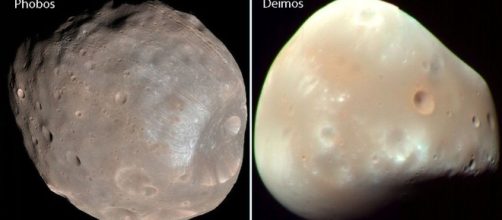The Japan Aerospace Exploration Agency (JAXA) has announced Japan’s first interplanetary mission in the form of the Martian Moon eXploration Mission (MMX). The MMX mission would launch in 2024 to arrive in Mars orbit in 2025. The probe will study the Moons Of Mars, Phobos and Deimos, as well as they surrounding environment of the Red Planet. MMX will also touch down on Phobos, take a sample, and return it to Earth in 2029.
Two theories exist as to the origin of the moons of Mars. One suggests that they are captured asteroids which wandered into the Red Planet’s gravitational influence.
Previous observations of Phobos and Deimos seem to suggest that they look like asteroids. The other theory posits that the two moons were debris that was kicked up from an ancient impact on the Martian surface such as happened on Mars’ northern hemisphere billions of years ago. The MMX should be able to ascertain which theory is correct.
The MMX will carry an instrument provided by the French Centre National d'Etudes Spatiales (CNES). The device will consist of a high-resolution infrared camera and spectrometer. The device will allow the surfaces of Phobos and Deimos to be examined pixel by pixel with a resolution of within a few tenths of a meter. The camera/spectrometer will be able to map out the best landing site on Phobos when MMX is ready to take its geological sample.
The MMX will represent the latest in an armada of probes that are being sent to Mars, either to study the Red Planet from orbit or to land on its surface, such as the Mars Curiosity and the upcoming Mars 2020 rover. The mission also is part of what amounts to an Asian competition for the status of the preeminent space power in that region. India has already sent its Mangalyaan probe to Mars orbit and is already planning a lander for 2021 or 2022. China is planning a Mars orbiter, lander, and orbiter by 2020.
Mars has always held a fascination for advocates of space exploration, going back decades. Some would like to search for life on the Red Planet, perhaps surviving from the time Mars was a lush, green world before its atmosphere leached away on the solar wind and its water evaporated.
Others dream of settling Mars, making it the second branch of human civilization, perhaps terraforming it to become Earth-like again. Currently, NASA plans to land people on Mars sometime in the 2030s, a program subject to change with the Trump administration eying a return to the moon.

